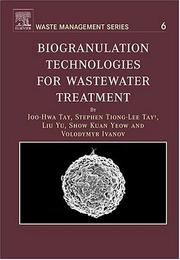| Listing 1 - 2 of 2 |
Sort by
|
Book
ISBN: 9264070427 9789264070424 Year: 2001 Publisher: Paris : OECD Publishing,
Abstract | Keywords | Export | Availability | Bookmark
 Loading...
Loading...Choose an application
- Reference Manager
- EndNote
- RefWorks (Direct export to RefWorks)
This Test Guideline describes two simulations tests used in the aerobic sewage treatment. Activated Sludge Units are designed to determine the elimination and the primary and/or ultimate biodegradation of water-soluble organic compounds by aerobic micro-organisms in a continuously operated test system simulating the activated sludge process. Two continuously operated test units are run in parallel under identical conditions. Normally the mean hydraulic retention time is 6 h and the mean sludge age is 6 to 10 days. Sludge is wasted by one of two methods, the test substance is normally added at a concentration of between 10 mg/l dissolved organic carbon (DOC) and 20 mg/l DOC, to the influent of only one of the units. The second unit is used as a control. The DOC, preferably, or chemical oxygen demand (COD) is determined, together with the concentration of the test substance by specific analysis, in the effluent from the unit receiving the test substance. In Biofilms, synthetic or domestic sewage, and the test substance, in admixture or alone, are applied to the internal surface of a slowly rotating inclined tube. A layer of microorganisms is built up on the internal surface. Effluent from the tube is collected and either settled and/or filtered before analysis for DOC and/or the test substance by a specific method. Control units are operated in parallel under the same conditions. The difference between the concentrations of DOC/COD in the effluent from the test and control units is assumed to be due to the test substance. This difference is compared with the concentration of the added test substance to calculate the elimination of the test substance. Biodegradation may normally be distinguished from bio-adsorption by careful examination of the elimination-time curve.
Environment --- Aerated package treatment systems --- Evaluation --- Aeration package plants --- Aeration package treatment plants --- Aerobic on-site systems --- Aerobic package plants --- Aerobic plants (Sewage disposal) --- Aerobic sewage treatment systems --- Aerobic sewage treatment units --- Aerobic treatment units --- Aerobic wastewater treatment systems --- APTS (Sewage disposal) --- Sewage disposal plants --- Evaluation.

ISBN: 1281050199 9786611050191 0080476082 0080450229 9780080450223 9780080476087 9781281050199 6611050191 Year: 2006 Publisher: Oxford : Elsevier,
Abstract | Keywords | Export | Availability | Bookmark
 Loading...
Loading...Choose an application
- Reference Manager
- EndNote
- RefWorks (Direct export to RefWorks)
Microbial granules have practical importance in anaerobic and aerobic biological wastewater treatment. Advantages of granules are retention of biomass in reactor, diversity of microorganisms, complex structure, and resistance to unfavorable conditions. Microbial granules can be used to treat municipal and industrial wastewater for removal of organic matter, xenobiotics, nutrients, and heavy metals. The book covers almost all aspects of formation and use of microbial granules in wastewater treatment. The data on aerobic microbial granulation are related mostly to laboratory systems due
Aerated package treatment systems. --- Sewage --- Biological products --- Purification --- Anaerobic treatment. --- Granulation. --- Granulation --- Anaerobic digestion (Sewage purification) --- Sewage sludge digestion --- Upflow anaerobic sludge blanket reactors --- Aeration package plants --- Aeration package treatment plants --- Aerobic on-site systems --- Aerobic package plants --- Aerobic plants (Sewage disposal) --- Aerobic sewage treatment systems --- Aerobic sewage treatment units --- Aerobic treatment units --- Aerobic wastewater treatment systems --- APTS (Sewage disposal) --- Sewage disposal plants --- Biological treatment
| Listing 1 - 2 of 2 |
Sort by
|

 Search
Search Feedback
Feedback About UniCat
About UniCat  Help
Help News
News